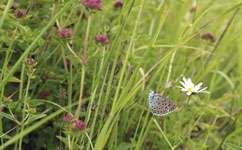Scientists call for cost-effective conservation

Britain could get more benefit from its conservation budget if it paid more attention to how effective and cost-efficient previous efforts to protect biodiversity have proved.
A new study suggests that conservation is heavily biased towards certain mammals and birds, with little attention to less glamorous species.
"A more balanced approach could be helpful," says Dr. Piran White, an ecologist at the University of York and one of the authors of the paper, published in Ecological Economics. "For example, if we spent more on conserving invertebrates we'd probably get more overall benefit from an ecological perspective."
Researchers looked at 38 Species Action Plans (SAPs), part of the UK Biodiversity Action Plan, which is intended to respond to the steep decline in many species over recent decades. They sent a detailed questionnaire to the people managing each project.
The team used the responses to their questionnaire to analyse SAPs' effectiveness. They looked at whether each SAP improved the target species' conservation status – for example, by turning a 'critically endangered' species into one that's merely 'vulnerable' – and at how far it reduced the threats the species faces. They then calculated how cost-efficient each project was.
The team found that effectiveness and efficiency were not always closely linked. Some SAPs, such as that for the wildflower deptford pink, were both effective and efficient. Others, especially some of the bird and mammal SAPs, were effective but not very efficient because they were so expensive. For example, the capercaillie SAP has improved the bird's conservation status but at a cost of approximately £7 million to date. Meanwhile the SAP for the heath fritillary has also been expensive, but has delivered relatively little conservation gain.
White says that in the long term, reducing the threats to a species is a better goal than improving its conservation status. Targeting the latter can end up with conservationists effectively farming an area for one species, whereas dealing directly with the threat may also benefit many other plants and animals.
For example, guarding sites of a rare plant such as the lady's slipper orchid can help maintain or even enhance its conservation status locally. But it doesn't address the underlying threats these species face, such as soil nitrification or competition from other native or invasive plants. "If you were reintroducing a species that had gone extinct in the UK, you'd be improving its conservation status in the short term," White says. "But if you didn't address the threats that had caused it to die out in the first place, you probably wouldn't succeed."
It's no secret that people generally care more about fluffy mammals and majestic birds than about small, seemingly insignificant invertebrates, but the paper suggests the imbalance may be bigger than previously suspected. 80 per cent of the funds went to just five of the 38 SAPs.
This bias is partly because many of these projects are supported financially from non-government organisations such as the RSPB, which in turn depend on donations from the public.
"The funding is very biased, but this probably reflects society's views," White says. Protecting well-known and beloved species can have knock-on benefits for whole ecosystems, but this isn't always the case. In some situations we would get more bang for our buck from looking after less prominent creatures.
This is especially true when looking at ecosystem services – benefits the natural environment provides to society, like water purification, waste disposal or flood control. These often depend on organisms that rarely hit the headlines.
Government policy is moving more towards basing conservation measures on scientific evidence, and towards protecting whole ecosystems rather than particular species. But White says scientists and policy-makers need to do more to explain the idea of ecosystem services – most people still don't know what they are.
The team had originally hoped to look at the effectiveness of spending in terms of its impact on these services. But they found that the data on this is too scanty to be used in such calculations, so they had to focus instead on the effect of conservation spending on species' conservation status and threats.
"We definitely need better data," White argues. "There's a huge information gap; in many cases we have no clear idea of how much money has been spent on particular conservation programs, or of how much benefit this has provided. We need to be able to link outcomes back to investments to see whether money has been well spent, and we need a much better understanding of how the conservation of individual species and habitats relates to ecosystem functions and the services they provide."
White stresses that the study's economic approach is just one way of looking at these problems, but he believes that bringing it into the decision-making process will help us get more benefit from our limited conservation resources.
This story is republished courtesy of Planet Earth online, a free, companion website to the award-winning magazine Planet Earth published and funded by the Natural Environment Research Council (NERC).
Provided by PlanetEarth Online











010.jpg)



